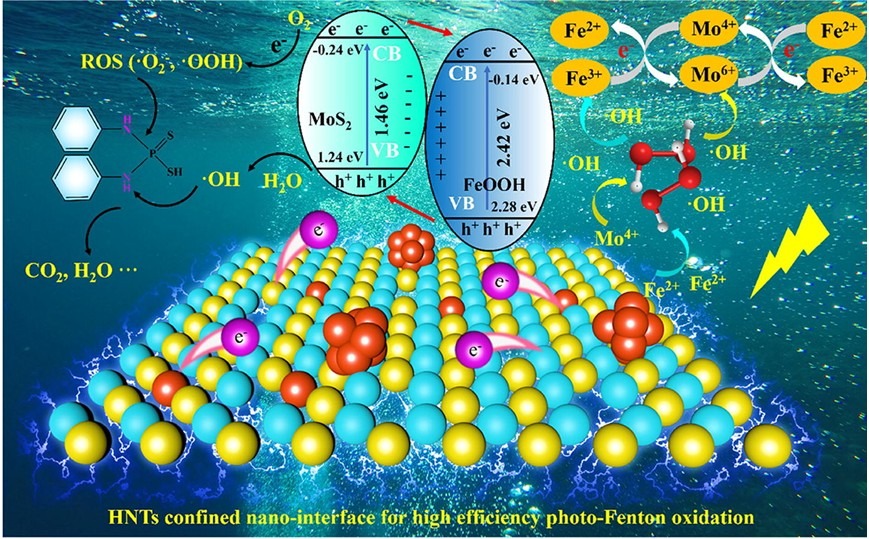Authors: Liu Wei
Corresponding authorProf. Dong Yingbo, Prof. Lin Hai
Communication UnitSchool of Energy and Environmental Engineering, University of Science and Technology Beijing
DOI: https://doi.org/10.1016/j.cej.2022.138666.
✦Graphic Summary✦

✦Results Profile✦
Recently, Wei Liu, a PhD student in the group, published a paper entitled "Halloysite nanotube confined interface engineering enhanced catalytic oxidation of photo-Fenton reaction for aniline aerofloat degradation: Defective heterojunction for electron transfer regulation". In this study, tens of nanometers of MoS were generated in situ on the inner and outer surfaces of mineral nanotube aerofloat (HNTs) by means of a clever structural design with the help of spatially confined domains of HNTs.2crystal clusters, and further, to promote MoS2Rapid separation of photogenerated carriers in the bulk phase, introduction of FeOOH in MoS2Defect-rich heterojunctions were constructed at the interface, and finally defect-rich HNTs@MoS were prepared.2/Fe composites and used for photo-Fenton degradation of aniline black agents in mineral processing wastewater. The morphology, structure and photoelectrochemical properties of different defective heterojunction catalysts were investigated in detail. A series of comparative catalytic experiments were performed to compare the activity of the defective heterojunction catalysts and also to discuss the effect of the main parameters of the wastewater on the AAF removal. Importantly, the detection of Fe2+/Fe3+The dynamics of the ratios to evaluate the photogenerated electrons and MoS in the photo-Fenton system2For system Fe2+The cyclic regeneration of the Combined with first-principles density flooding theory (DFT) calculations, the HNTs@MoS were revealed by visualizing the electron transfer process and charge distribution2The key role of defective heterojunctions in /Fe in the electronic regulation of catalytic processes.
✦Abstract✦
Aniline black drug (AAF), a major flotation reagent widely used in mineral processing, has been neglected for its persistent toxicity and undesirable odor to the environment. In this study, in situ growth of defect-rich MoS inside and outside HNTs by spatially restricted domain action2/FeOOH for the complete degradation of AAF.The results showed that the photo-Fenton reaction degraded about 99% of AAF in 60 min, and the corresponding apparent kinetic constants (Kobs) reached 0.223 min-1, which is much higher than what has been reported recently. Interestingly, HNTs@MoS2/Fe can adjust the pH of the reaction system to keep it in the right range, and it can efficiently degrade AAF even at an initial pH of 7. TEM images show that MoS2The particle size of the /FeOOH hybrid is 10-50 nm, which is very favorable to reduce the diffusion distance of the active oxygen and avoid self-consumption. XPS and EPR results confirm that the catalyst with unsaturated S-edge and defects effectively promotes the active center and electron transfer. More importantly, the separated electrons modulate the Mo4+/Mo6+and Fe3+/Fe2+cycle, which maintains the H2O2decomposition to stabilize the production of reactive oxygen species. The regenerated Fe2+and Mo4+For H2O2DFT calculations demonstrate that S-defects and FeOOH heterojunctions contribute to the photogenerated electrons from MoS2Fast migration to FeOOH and realization of e–/h+separation, which is the main driving force to sustain ROS generation in the photo-Fenton system. This work will provide an ingenious idea for the preparation of low-cost and highly durable synthesis of elosite domain-limited catalysts for the removal of refractory organic pollutants.
✦Author✦

Wei Liu, a PhD student in Environmental Science and Engineering, University of Science and Technology Beijing, Class of 2020, is engaged in research on water pollution control, photocatalytic water purification, Fenton oxidation technology and catalytic materials for environmental water purification. He is responsible for many projects such as Dongying groundwater environmental condition survey and assessment project, and participated in Beijing drinking water source pollution source survey. Finally, I would like to congratulate Dr. Wei Liu once again and wish the graduate students of the group to keep innovating and make further efforts to achieve fruitful results.
Source: Environmental Biotechnology and Environmental Materials Development Team Public

